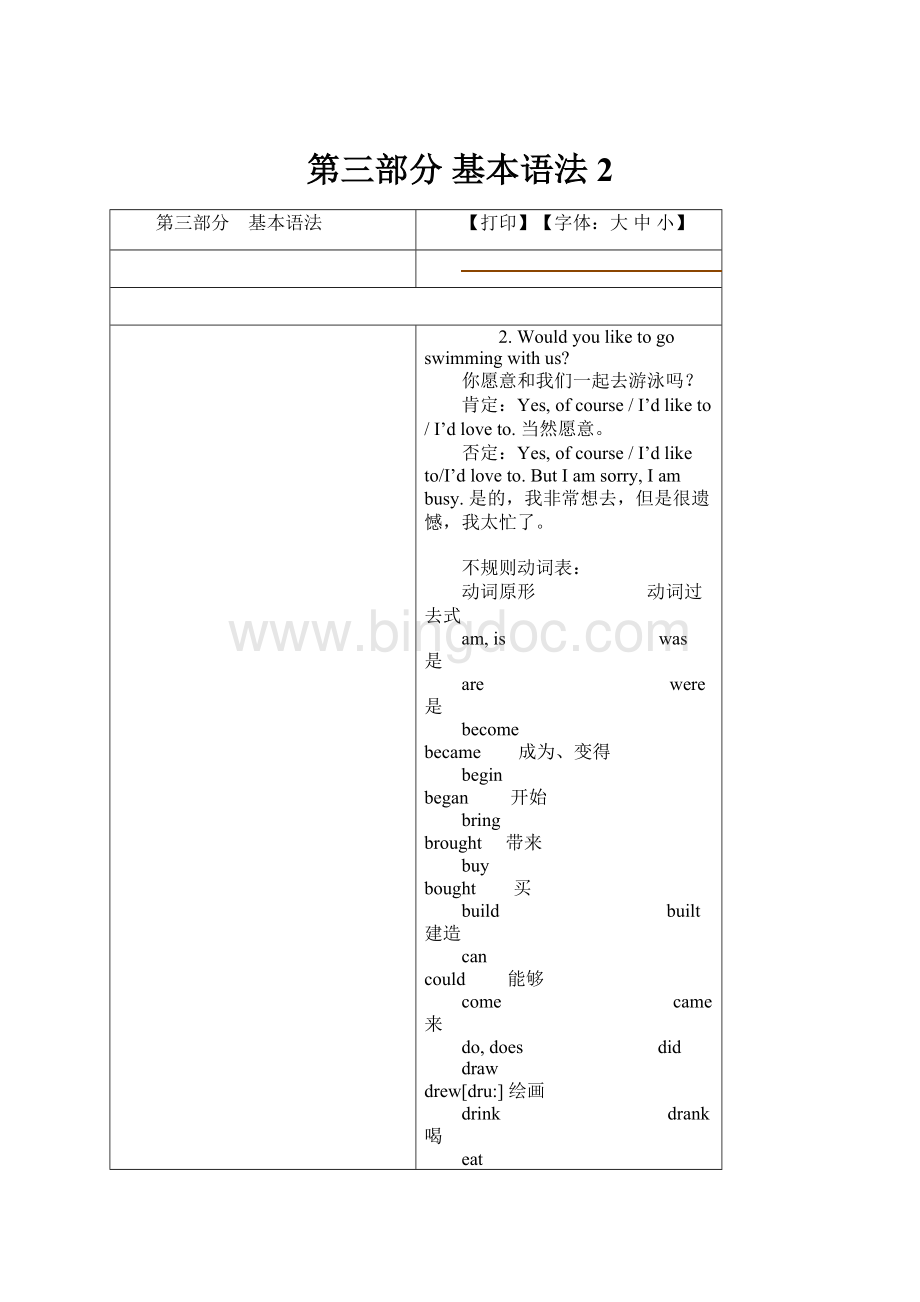第三部分基本语法2Word文档格式.docx
《第三部分基本语法2Word文档格式.docx》由会员分享,可在线阅读,更多相关《第三部分基本语法2Word文档格式.docx(28页珍藏版)》请在冰点文库上搜索。

give gave 给
go went 去
grow grew 长大、成长
have/has had 有
hear heard 听见
hold held 握住、拿住
keep kept 保持、保存
know knew 知道
leave left 离开
let let 让、允许
lose[lu:
z] lost 丢失
make made 制作
meet met 遇见、碰面
pay paid 付款
put put 放置
read read 读
ride rode 骑、乘
run ran 跑
say said 说
see saw 看见
sell sold 卖
send sent 发送、寄
shall should 将要
sing sang 唱
sit sat 坐
sleep slept 睡、睡觉
sweep swept 打扫
swim swam 游泳
take took 取、拿走
teach taught 教
tell told 告诉
think thought 想、认为、思考
wear wore 穿
will would 将要
win won 赢、获胜
write wrote 写
练习:
1.写出下列动词的过去式:
ask→ finish→ cook→ like→
study→ carry→ hurry→ try→
stop→ shop→ fit→ come→
see→ swim→ run→ teach→
begin→ leave→ read→
II.把下列句子变成否定句和一般疑问句,并做出肯定回答或否定回答:
1.Heboughtanewcaryesterday.
→
→
2.TheylistenedtotheEnglishtapelastnight.
3.Mybrotherplayedbasketballjustnow.
Ⅰ.Revision
一般过去时指过去某一时间所发生的动作或存在的状态。
ⅰ.be动词的一般过去式
1.肯定句:
Iwasbusyyesterday.我昨天很忙。
Shewashappylastnight.她昨天晚上很高兴。
Theboyswereintheparkjustnow.这些男孩儿刚才在公园里。
2.否定句:
Iwasn’tlateforschoolyesterday.昨天我上学没迟到。
Hewasn’tathomelastnight.他昨晚不在家。
Theyweren’tinAmericalastsummer.去年夏天他们不在美国。
3.一般疑问句及回答:
1.Wasitsnowingyesterdayafternoon?
昨天下午下雪了吗?
Yes,itwas./No,itwasn’t.
2.Werethechildrenhappyatthepartylastnight?
昨天晚上孩子们在宴会上快乐吗?
Yes,theywere./No,theyweren’t.
3.Wereyoulateforworkthismorning?
今天早上你上班迟到了吗?
Yes,Iwas./No,Iwasn’t.
4.特殊疑问句:
1.Wherewereyouyesterdaymorning?
昨天上午你在哪里?
Iwasinthelibrary.我在图书馆。
2.WhywasMarylateformeetingyesterday?
昨天为什么Mary开会迟到了。
Becauseshewasill.因为她生病了。
ⅱ.实义动词作谓语的一般过去式
1.肯定句:
JohnstudiedChineseinYuyingMiddleSchoolin1999.
John于1999年在育英中学学习中文。
MyparentswenttotheForbiddenCitylastSunday.
上周日,我父母去了紫禁城。
2.过去式的变化规则:
动词过去式的构成规则:
1)一般在动词词尾加-ed;
work→worked help→helped watch→watched
2)以e结尾的动词后加-d;
live→lived like→liked decide→decided hope→hoped
3)以“辅音+y”结尾的词将y变i再加ed;
study→studied carry→carried try→tried cry→cried
以元音字母加y结尾的动词加-ed;
play→played
4)以重读闭音节结尾,末尾只有一个辅音字母的词,双写最后一个辅音字母再加-ed;
stop→stopped drop→dropped fit→fitted
5)不规则动词:
go→went see→saw make→made buy→bought
have→had do→did get→got build→built
3.否定句:
需借助助动词didn’t,如:
Theydidn’tcarrytwoboxestothefactoryyesterday.
昨天他们没有把两只箱子搬运到工厂。
Wedidn’twatchTVlastnight.昨天晚上我们没有看电视。
Hedidn’teatlunchathomeyesterday.昨天他没在家吃午饭。
注意:
助动词didn’t放在主语后面,谓语动词要恢复原形。
4.一般疑问句:
DidshewatchTVfortwohourslastnight?
Yes,shedid./No,hedidn’t.
Didheeatlunchathomeyesterday?
Yes,hedid./No,hedidn’t.
DidyourmothercooknoodleslastSunday?
Yes,hedid./No,hedidn’t.
DidtheyliveinBeijingin1996?
Yes,theydid/No,theydidn’t
5.特殊疑问句
Wheredidyougoyesterday?
昨天你去哪儿了?
IwenttotheSummerPalace.我去颐和园了。
howmanysubjectsdidtheystudylastterm?
上学期他们学习了几门课?
Theystudiedsevensubjects.他们学习了七门课。
Whatdidyoudolastnight?
昨天晚上你们干什么呢?
WelistenedtoEnglishsongslastnight.
我们昨晚听了英语歌曲。
Ⅱ.不可数名词
1.复习可数名词的复数形式:
1)可数名词的复数形式,一般在单词后面加s;
2)在s,x,sh,ch结尾的单词后加es;
3)以o结尾的词,多数加es,少数加s;
4)以f,fe结尾的词,通常把f,fe变为v,再加es;
5)以“辅音+y”结尾的名词,把y变成i,再加es。
“元音+y”结尾的词则加s;
6)单复数同形(词形不变);
7)不规则的复数形式(特殊变化)。
2.不可数名词
大多数表示抽象概念的名词和物质名词是不可数名词,只有单数形式:
例如:
milk牛奶,tea茶,water水,meat肉,bread面包,honey蜂蜜,time时间,wine酒,paper纸,weather天气,homework家庭作业,news新闻、消息,advice建议等等。
怎么表示不可数名词呢?
1)借助单位词,量词来表示一定数量。
例如:
aglassofmilk一杯牛奶
abottleofwater一瓶水
apieceofpaper一张纸
acupoftea一杯茶
这里的一杯、一瓶、一张就是量词。
因为不可数名词只有单数,所以常借助量词来表示不可数名词的数量,如:
twoglassesofmilk两杯牛奶
twopiecesofadvice两条建议
threebottlesofwater三瓶水
tenpiecesofpaper十张纸
fourbowlsofmeat四碗肉
fivepiecesofbread五片面包
threecupsoforangejuice三杯橘汁
2)用some(一些),much(许多的),alittle(一点),alotof(许多的,大量的),plentyof(充足的,大量的)+不可数名词来表示数量,如。
somewater一些水 alittletime一点时间
plentyofsnow大量的雪 someadvice一些建议
六、therebe结构
I.表“存在”的句型:
therebe
Therebe指的是thereisthereare
thereis+名词单数(或不可数名词)+表示场所的词或词组
thereare+名词复数+表示场所的词或词组
1.Thereisabookonthedesk.在课桌上有一本书。
2.Thereisacarinfrontofthehouse.在房子前面有一辆小汽车。
3.Thereissomewaterinthebottle.在瓶子里有一些水。
4.Therearealotofflowersinthegarden.在花园里有许多花。
5.TherearesomeCDsbehindthecomputer.在电脑后面有一些CD。
6.Therearetwoballsunderthebed.床底下有两个球。
方位词:
in在……里面on在……上面infrontof在……前面
behind在……后面under在……下面between…(and)在……之间
across…from在…的对面nextto挨着,相邻
2.therebe句型的否定式
变否定句时,在be动词后面加上not,缩写形式为:
isn’t,aren’t。
1.Thereisn’tanywaterinthebottle.
瓶子里没有水。
2.Therearen’talotofflowersinthegarden.
在花园里没有多少花。
3.Therearen’tanyCDsbehindthecomputer.
在电脑后面没有CD。
4.Therearen’ttwoballsunderthebed.
床底下没有两个球。
※some和any
这两个单词都表“一些”,some用于肯定句,any用于否定句和一般疑问句中。
3.一般疑问句
1)Isthereabookonthedesk?
在课桌上有一本书吗?
Yes,thereis,/No,thereisn’t.
2)Isthereanywaterinthebottle?
在瓶子里有水吗?
3)Aretherealotofflowersinthegarden?
在花园里有许多花吗?
Yes,thereare./No,therearen’t.
4)ArethereanyCDsbehindthecomputer?
在电脑后面有CD吗?
Yes,thereare./No,therearen’t.
II.have/has
1.have/has表示“占有、所有”,主语为具体的人或事物。
如:
1)Ihaveabeautifulwatch.我有一只漂亮的手表。
2)Thechildrenhavesomecartoonbooks.
孩子们有一些漫画书。
3)Sallyhasaredbag.Sally有一个红色的书包。
4)Hehasabighouse.他有一所大房子。
2.否定句:
1.Ihavesomebananas
→Idon’thaveanybananas.我没有香蕉。
2.Thechildrenhavesomecartoonbooks.
→Thechildrendon’thaveanycartoonbooks.孩子们没有漫画书。
3.Sallyhasaredbag.
→Sallydoesn’thavearedbag.Sally没有红色的书包。
4.Hehasanewcar.
→Hedoesn’thaveanewcar.他没有新车。
3.一般疑问句:
1.Doyouhaveanywater?
你有水吗?
Yes,Ido./No,Idon’t.
2.DotheyhaveanyJapanesebooks?
他们有日语书吗?
Yes,theydo./No,theydon’t.
3.DoesSallyhaveablouse?
Sally有红色上衣吗?
Yes,shedoes./No,shedoesn’t.
4.Doeshehaveamobilephone?
他有手机吗?
III.therebe句型的特殊疑问句
1.Thereare((two))ballsunderthebed.
床底下有两个球。
→Howmanyballsarethereunderthebed?
2.Thereare((fifty))studentsinourclass.
在我们班有50个学生。
→Howmanystudentsarethereinyourclass?
Dialogue:
1.—HappyNewYear!
新年好!
—Thesametoyou也祝你新年好!
2.—MerryChristmas!
圣诞节快乐!
—MerryChristmas!
3.—Congratulations!
祝贺!
—Thankyou!
4.—Haveagoodtime!
祝玩得高兴!
—Thankyou.Thesametoyou!
谢谢,你也快乐。
5.—Whataboutgoingforawalknow?
现在出去散步怎么样?
—That’sagoodidea!
/Thatsoundsnice!
/Allright.
好主意!
/听起来不错!
/好吧。
—I’msorry,I’mafraidIhavenotime.
不好意思/对不起,恐怕我没有时间。
七、形容词和副词的比较级,最高级:
Ⅰ.比较级
两个人或物相比较叫比较级。
than:
比
例句:
1.MikeistallerthanPeter.Mike的个子比Peter高。
2.Iamshorterthanyou.我比你矮。
3.Thesequestionsareeasierthanthosequestions.这些问题比那些问题容易。
4.Thepandaisfatterthanthemonkey.熊猫比猴子胖。
5.Theelephantisheavierthantherabbit.大象比兔子重。
6.Whichcityislarger,BeijingorTianjin?
哪一个城市比较大,北京还是天津?
句子结构:
主语+be动词+形容词/副词的比较级(er)+than+人或物
单音节(及少数双音节词)形容词或副词比较级的构成规则:
1.在形容词或副词后面直接加er
all→taller short→shorter hard→harder
long→longer fast→faster warm→warmer
2.以—e结尾的词只加—r
large→larger brave→braver fine→finer
3.以重读闭音节结尾的词,词尾是一个辅音字母,双写辅音字母再加—er
hot→hotter big→bigger wet→wetter thin→thinner
fat→fatter red→redder
4.以辅音字母+y结尾的词,变y为i,再加—er
easy→easier happy→happier busy→busier early→earlier
5.不规则
good/well→better bad/ill→worse
(注:
为了更好的叙述及记忆,这里所讲的单音节词中包括少数几个双音节词。
)
many/much→more little→less far→farther
例句
(二):
1.TomismoreoutgoingthanJim.Tom比Jim外向。
2.Theicecreamismoredeliciousthanthehamburger.冰淇淋比汉堡包更美味。
3.Sheismorepopularthanyou.她比你更受欢迎。
4.Thesestoriesaremoreinterestingthanthosestories.
这些故事比那些故事更有趣。
主语+be动词+more+形容词/副词+than+人或物
多音节,就是单词里有三个以上的元音读音。
大多双音节词和多音节的比较级在它们之前加more。
这里,为了更好的叙述及记忆,老师在讲解过程中并未提及到双音节词,而是把这部分词归入